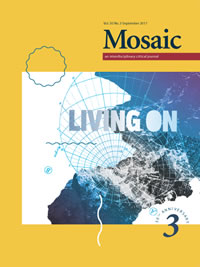Issue 50.3
Overview

Special Issue: Letters
Published: September 2017
View the issue introduction or see the issue summary and contents below.
11 essays, totalling 200 pages
$24.95 CAD
Traditionally, letters have been regarded as “non-serious” or at least as superfluous to the critical enterprise proper (consider Kant’s division of Plato the letter-writer from Plato the philosophical father). But can letters themselves be considered critical forays and/or keys to the inheritance of scholarly work? Might letters put the serious/non-serious opposition into question? This issue considers letters in relation to understanding a writer’s or artist’s body of work; alternate histories; friendship; auto-bio-graphy; archival and digital repository research; and email and electronic posting.
Love, Infidelity, and Postcards: Derrida and JoyceStephen Abblitt Pursuing themes of love and infidelity, this performative, post-critical essay demonstrates the “postal effect,” theorized and practiced in Jacques Derrida’s The Post Card, and exhibits how the epistolary genre—its lost love letters and perfidious postcards, always already errant, straying—foregrounds Derrida’s approaches to the writings of James Joyce. | |
Orienting Nietzsche’s ‘Nearest Things’ in Kafka’s Letters to FeliceJill Marsden Franz Kafka’s five-year correspondence with Felice Bauer is marked by an unusual fascination with the practice of writing and receiving letters and with the minutiae of the everyday. I suggest that Friedrich Nietzsche’s notion of the “nearest things” illuminates Kafka’s letter-writing as an embodied style or “orientation” of thought. | |
CGL: Apotropocalyptic Cod(ic)es of LettersJohn P. Leavey The margins of letters as genre, literature, and theory are explored in an intertextual polylogue on John Barth’s LETTERS and Jacques Derrida’s Glas and La carte postale. | |
From Friction, Heat: Kroetsch, Spanos, and boundary 2David Eso Canadian poet, novelist, and critic Robert Kroetsch co-founded the journal boundary 2 with American critic and philosopher William Spanos. The editors’ relationship, marked by sympathy and difference, informed this enduring publication’s early history. | |
Enigmatic Epistolarity: Twombly’s Letter of ResignationPeter Schwenger Looking at first merely like 38 scribbled pages, Twombly’s Letter of Resignation shows how writing’s essence, as Barthes argues, is most evident when it is illegible. The series illuminates letter-writing as a process; writing’s relation to drawing; and the way the hand’s traces reveal the emotions that impelled it. | |
Abu Ben Bail: A Creative Writer Reads Murray Bail’s Archived CorrespondenceMoya Costello The archived correspondence of Australian author Murray Bail in the National Library of Australia, along with letters he has sent to others that are held in their archives, enable this portrait of Bail, his contemporaries, their historical time, and of the archive itself. | |
La grandeur d’un genre mineur: La lettre, vecteur social et littéraireAstrid Van Assche La lettre, souvent minorée par la critique, peut constituer un important vecteur littéraire et social pour ses contemporains, ainsi qu’un document de premier ordre pour les chercheurs en littérature et sociohistoire. Cet essai analyse le rôle de la correspondance mondaine dans la sociabilité et la littérature du XVIIe siècle. | |
Les lettres de John Keats : Profondeur et légèreté d’un poète épistolierSylvie Crinquand Cet essai revisite la correspondance de John Keats à la lumière de la distinction entre sérieux et légèreté, pour démontrer que c’est grâce à la légèreté inhérente au genre épistolaire que le poète parvient à utiliser un espace privé pour coucher sur le papier ses pensées les plus profondes. Sa démarche est analysée en lien avec la théorie de l’épistolaire, mais aussi avec l’histoire du genre, de manière à plaider pour une lecture contextualisée des lettres du poète. | |
Epistolary Sadomasochism in A.C. Swinburne’s Love’s Cross-Currents: A Year’s LettersPatricia Pulham Written in letter form, Love’s Cross-Currents: A Year’s Letters, A.C. Swinburne’s only completed novel, mimics the epistolary fiction of the eighteenth century. This essay argues that Swinburne exploits this genre’s engagement with spectacles of suffering to afford his readers access to sadomasochistic pleasures. | |
Prehistoric Life Writing: Letters from the FloodCamilla Bostock Through the form of a series of fragmented letters, I explore the notion of “prehistoric life writing,” alongside questions of epistolarity and the figure of the flood, in the work of J.G. Ballard (my letters’ posthumous addressee), D.H. Lawrence, and Jacques Derrida. | |
Addressed to You: Nonhuman Missives from Elizabeth Bowen’s A World of LoveJemma Deer Elizabeth Bowen’s 1955 novel A World of Love arrives in our hands today like a letter from the past, insisting that we recognize the nonhuman forces at work in every act of writing and reading—as well as the ethical injunction such an apprehension engenders. |